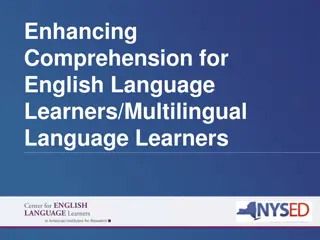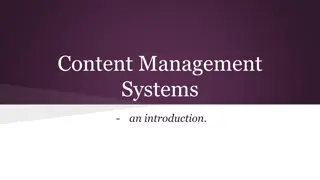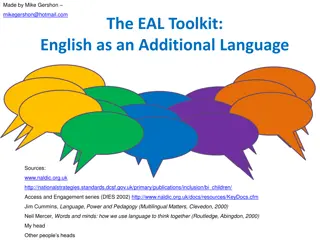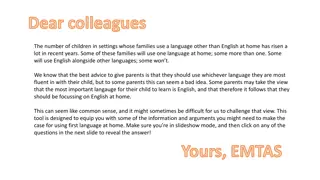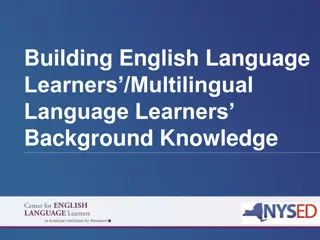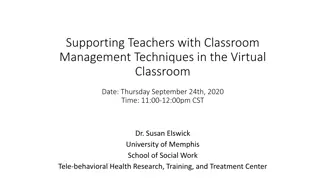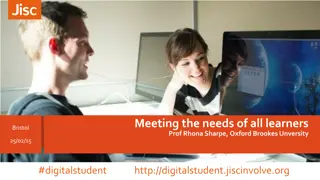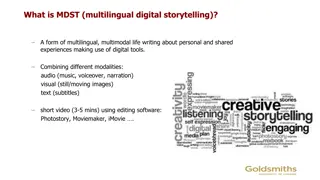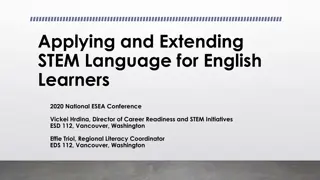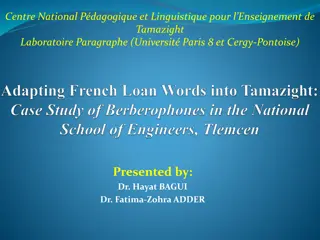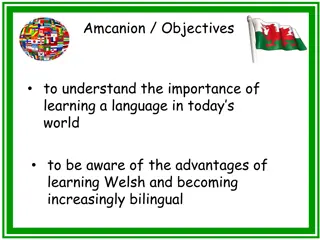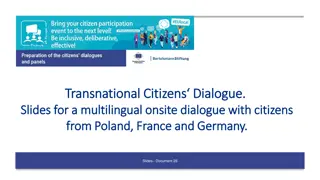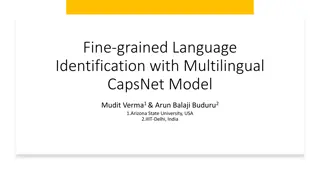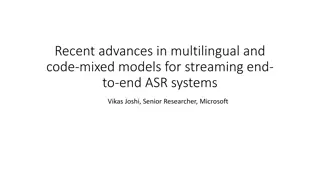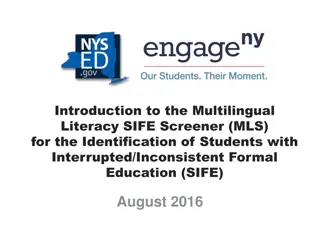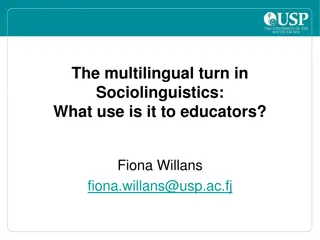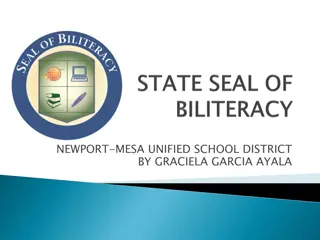Supporting Multilingual Learners in the Content Classroom
Explore different strategies and resources for working with multilingual learners in the content classroom. Discover ways to differentiate instruction, support academic language development, and address the needs of gifted students and those with IEPs. Aim to challenge students in their learning zones and provide essential language-focused support tailored to individual proficiency levels.
Uploaded on Oct 10, 2024 | 0 Views
Download Presentation

Please find below an Image/Link to download the presentation.
The content on the website is provided AS IS for your information and personal use only. It may not be sold, licensed, or shared on other websites without obtaining consent from the author. Download presentation by click this link. If you encounter any issues during the download, it is possible that the publisher has removed the file from their server.
E N D
Presentation Transcript
Working with Multilingual Learners in the Content Classroom Catherine Box January 13, 2020
Agenda o Revisiting Differentiation in the Content Classroom o Academic Language in the Content Classroom: Implications and Resources for ELs o Error Correction (if time)
Differentiation in the Classroom, Revisited
For Gifted Students and Students with IEPs For Multilingual Learners We can differentiate for Content caution yes Process yes yes Product yes yes
Aim for the Challenge Zone! (Gibbons, 2009) HIGH CHALLENGE Learning/engagement zone Frustration/anxiety zone HIGH SUPPORT LOW SUPPORT Comfort zone Boredom zone LOW CHALLENGE
Essential Elements of Language- Focused Support Each support is matched to the language learner s proficiency level. Each support is respectful and engaging. Each support moves toward the same essential understanding.
Language supports work to meet the various language needs within your class. The supports should provide opportunities for multilingual learners to work at the same level as their peers.
What can be differentiated for MLLs? Lesson Plans Tasks Schema Activation Teacher Talk Materials Assessments (this afternoon) This morning
Task Support Checklist (adapted from Peregoy & Boyle, 2017) SCHEMA ACTIVATION Prepare students for tasks by activating their own background knowledge with an asset perspective in mind. Provide rich contextual information by giving backgroundfor tasks. DIFFERENTIATION OF INPUT Provide multiple opportunities for students to process information in multiple ways (visuals, dramatization, review, questions, think-pair-shares) Use abundancy and redundancy strategies when introducing key vocabulary. (repeat often, use in different contexts, write on board, highlight when using it, have students repeat it, give opportunities for students to use it). Provide multimodal directions/explanations (modeling, gestures, write & say simultaneously). Ask instruction-clarifying questions (e.g. what do we do first?) before setting students on task. Ensure participation of all students through providing sentence frames, allowing non-verbal contributions, and group task monitoring. MATERIALS Enhance input through bolding key vocabulary in materials. Provide word banks and glossaries for important terms. Provide brief explanations of grammar points as needed.
Video Clip Analysis View the following clip from a Global Studies classroom, in which 100 percent of the students are multilingual learners. Consider the following: What kinds of language-focused task support are being implemented? What else could be done to further support multilinguals in this content classroom? *I am not presenting this as a model of perfect ENL teaching. Instead, it is a real-life example of the kinds of task support possible in a content classroom.
ACADEMIC LANGUAGE WHAT IS IT? HOW CAN WE ENGAGE ALL OF OUR STUDENTS TO USE IT?
EXAMPLE OF ACADEMIC LANGUAGE The extended drought caused the crops to fail, resulting in a wide spread famine, and many deaths, especially among children and the elderly. (Gibbons, 2009, p. 5) TASK: AT YOUR TABLES, REWRITE THIS SENTENCE IN EVERYDAY LANGUAGE
What are the differences between these two texts? The extended drought caused the crops to fail, resulting in a wide spread famine, and many deaths, especially among children and the elderly. There was no rain for a very long time. The farmers had planted crops like wheat and corn, but because it did not rain, all the crops died. Because there were no crops, there was nothing for the people to eat , and they became very hungry. Because they did not have enough to eat, many of them died, especially the children and old people.
Elements of Academic Language Vocabulary --evokes abstract concepts (ex. the US government, existentialism ). --contains specialized, subject-specific vocabulary (ex. algorithm, convex, Majority Whip ). Sentence Structure --uses nominalization (ex. the legalization of drugs, multiplication of variables ). --uses passive voice (e.g. the war was caused by poverty ). --often has embedded clauses (e.g. Most Thursdays found the boys on Fairview, waiting for the bars to leak their patrons into the morning. [The New Yorker, 10/29/2018]) --less explicit than everyday language. Thus, more inference is needed. (see sentence from The New Yorker)
Basic Interpersonal Communication Skills vs. Cognitive Academic Language Proficiency (Cummins, 1979)
From CALP to BICS Task: Rewrite these sentences into language we would find in BICS Peter Schaghen, the liaison between the Dutch government and the Dutch West India Company, made one of the earliest known references to the purchase of the Manhattan Island for 60 guilders from the Lenape Indians. (The Purchase of Manhattan Island, 1626, thirteen.org) An algorithm must be composed entirely of primitives. Naturally, the primitive operations of different individuals (or machines) vary depending on their sophistication, experience, and intelligence. (Invitation to Computer Programming, 5th ed.)
Please note that academic language is not superior to language we hear in other situations. Using academic language appropriately is not a sign of high cognitive ability. It is indicative of familiarization with the type of language expected in (in this case, American) schools. Developing academic language helps access educational opportunities. It is part of a toolbox to help maximize access and agency for all children.
Ways to Scaffold Academic Language 1. Move Toward Academic Texts by asking top-down questions before giving texts, by building background information (see Session 1). 2. Pay Explicit Attention to Subject-Specific Vocabulary. Frontload some vocabulary, but do not make it overwhelming. This would require making decisions on a case-by-case basis. You might wish to adapt some complex texts, preferably with the help of the ENL teacher. 3. Model the Use Of Academic Language by re-voicing student contributions and replacing BICS with CALP. ex. Teacher: And what were your results? Student: Um, they stuck together. Teacher: Right! They stuck together, they attracted each other. 4. Talk Explicitly about Academic Language. Discuss what nominalization is and draw students attention to it. Have them re-word CALP into BICS
Ways to Scaffold Academic Language, contd 5. Word Walls with specialized vocabulary words and their meanings. 6. Semantic Webs can help students organize information. Vocabulary can be reinforced here, too.
Ways to Scaffold Academic Language, contd 7. Cloze Texts can make salient grammatical forms or vocabulary words. In summer people (1) ......... to grill because the sun is high and the days are much longer. Grill safety is an important element to having a great grill party. There are many important (2) ........ . to remember. The first is (3) ......... a grill that is safe and will last at long time outdoors. Buying a grill can be a challenging but it can also be fun. There are gas grills and charcoal grills as well. For safety, be sure to keep all the grill supplies away from children if you get a charcoal or a gas grill. Gas grills (4) ......... cost more money over time since you need to buy more gas. The food made with a gas grill also has a different flavor. The good news is that many modern grills work both with charcoal or gas! The second factor is to make sure you have cleaning supplies and the right tools for your grill. You should have (5) ......... tools that keep your hands and arms safe from getting burnt. You should also have supplies that allow you to keep your grill clean after use. This summer, enjoy grilling with safety and fun.
Resources www.newsela.com This site has both free and subscription levels. It provides authentic reading material in many different subject areas, and will adapt it based on lexile levels. Even if you are not familiar with lexile levels, you can eyeball different levels of adaptation. https://visuwords.com This interactive dictionary will generate word definitions in different ways. https://lextutor.ca/ This site is free, but not particularly user-friendly. You can watch youtube clips on how to maximize its offerings, which are considerable. You can: get a sense of how complicated a text is, compare two texts, get a sense of how frequent certain words are in a target language, and so much more. Designed by linguists. Websites discussing Academic Language http://www.colorincolorado.org/article/academic-language-and-ells-what-teachers- need-know https://www.edutopia.org/blog/8-strategies-teaching-academic-language-todd-finley
Errors are a natural part of language development Example: I went to the store I goed to the store --How is this a sign of development?
When should errors be corrected? --When communication is hindered. --When a word or phrase that is part of key vocabulary for the unit. --When there is signs of frustration or word searching. ----------------------------------------------------------- Do not correct so much that fluency is prevented. Do not correct mistakes related to nervousness.
Types of ORAL Corrective Feedback explicit implicit correction (most common) S: He is study. T: Studying. We say studying here. repeat back correctly (most common) S: Where she go? T: Where does she go? She goes to the store. elicitation of others to help S: He is study. T: That s not quite help. Can someone help John? confirmation check to get student to think about it S: Where she go? T: I m sorry? I don t understand. Can you repeat please? metalinguistic feedback to remind student of rules S: Where he is study? T: Can you think about your grammar? You need to use the -ing form. You also need to switch he and is because you are asking a question. S: Where she go? T: Where she go? Did you ask, where she go?
Types of WRITTEN corrective feedback Direct: Gives an indication of the error and provides correct form. Indirect feedback: Gives an indication that an error has been made. underlining the error indicating the number of errors in the margin inserting error codes in the text Metalinguistic feedback: provides explanations for the errors.
THANK YOU!! Catherine Box, Ed.D. cbox@upenn.edu Division of Educational Linguistics



